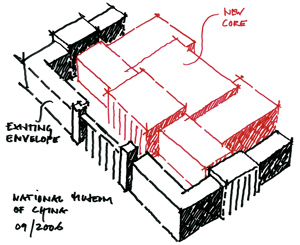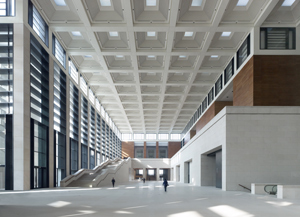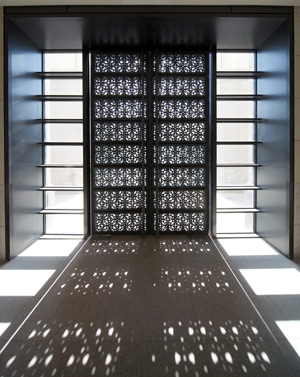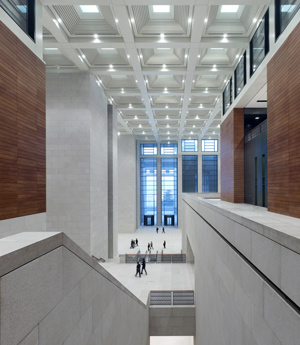 |
 |
 |
 |
 |
 |
| |
 |
|
 |
 |
 |
  |
  |
 |
 |
 |
 |
| NATIONAL MUSEUM OF CHINA BY GMP
|
|
April 21, 2011
 The conversion and extension of the Chinese National Museum combines the former Chinese History Museum with the Chinese Revolutionary Museum. Completed in 1959 as one of ten important public buildings in Tian’anmen Square, in direct proximity to the Forbidden City, the museum still constitutes a milestone in history of modern Chinese architecture. The conversion and extension of the Chinese National Museum combines the former Chinese History Museum with the Chinese Revolutionary Museum. Completed in 1959 as one of ten important public buildings in Tian’anmen Square, in direct proximity to the Forbidden City, the museum still constitutes a milestone in history of modern Chinese architecture.
Outline schemes for the conversion and extension project were invited from ten international architectural firms, the proposal by architects von Gerkan, Marg and Partners (gmp) together with CABR of Beijing being adjudged preferred bidder, ahead of Foster and Partners, Kohn Pedersen Fox, OMA and Herzog & de Meuron etc.
 The original submission by gmp envisaged gutting the existing museum. The central block would be removed, and the large space thereby created spanned by a bronze flying roof linking the old building and the extension. The flying roof was planned to house the main exhibition on Chinese history, with a direct view towards the sights of the city. Following a discussion with the client and Chinese architectural experts, this scheme was revised, with the aim of integrating more of the external impact of the old building in the new building, though without abolishing the immediately obvious distinction between old and new. This would allow the building itself to illustrate the continuity of history. The original submission by gmp envisaged gutting the existing museum. The central block would be removed, and the large space thereby created spanned by a bronze flying roof linking the old building and the extension. The flying roof was planned to house the main exhibition on Chinese history, with a direct view towards the sights of the city. Following a discussion with the client and Chinese architectural experts, this scheme was revised, with the aim of integrating more of the external impact of the old building in the new building, though without abolishing the immediately obvious distinction between old and new. This would allow the building itself to illustrate the continuity of history.
The task was to combine the northern and southern wings into an integral complex of buildings by removing the central structure to make the Chinese National Museum.
The 260m (850ft)-long hall acts as its central access area. It widens in the centre to embrace the existing central front entrance facing Tian’anmen Square. The ‘forum’ thus created acts as a vestibule and multifunctional events area, with all auxiliary service functions for the public attached – cafes and teahouses, bookshops and souvenir shops, and ticket offices and toilets.
 The classic tripartite division of China’s historical buildings governs the design of the ‘forum’ as well. A stone base serves as a platform for a wooden structure, with a coffered roof structure resting on a DCB layer on top of it. Despite the vastness of the ‘forum’, a homely atmosphere was sought, particularly in the harmonious use of materials – local granite on the ground floor and walls of the base layer and wooden cladding in the gallery area. The classic tripartite division of China’s historical buildings governs the design of the ‘forum’ as well. A stone base serves as a platform for a wooden structure, with a coffered roof structure resting on a DCB layer on top of it. Despite the vastness of the ‘forum’, a homely atmosphere was sought, particularly in the harmonious use of materials – local granite on the ground floor and walls of the base layer and wooden cladding in the gallery area.
The main entrance of the museum continues to be oriented towards the west, but, for the first time, the north and south entrances are linked via the ‘forum’. This space helps visitors to orientate, and all public areas of the almost 200,000 m2 (2,066 m sq. ft) building are accessed from here.
The dimensions of the ‘forum’ also relate to the sheer size of Tian’anmen Square and the size of the building itself. Around 8–10m people a year are expected to visit the National Museum. The architectural shape of the space is a contemporary interpretation of traditional elements of Chinese buildings. This is already evident in the west courtyard, accessed via broad steps reminiscent of the steps in front of the temple precincts in the Forbidden City just round the corner.
 The western entrance of the existing building, the Mengguobao facing Tian’anmen Square, is notable for its series of slender pillars, linked with each other by an entablature on the pattern of temple and palace architecture, with the roof structure resting on it. The west facade of the new building is planned analogously, the ‘dougong’ resting on its supports and carrying a prominent projecting roof. In historical Chinese architecture, the ‘dougong’ is a slightly projecting feature of bearings and joist ends. The western entrance of the existing building, the Mengguobao facing Tian’anmen Square, is notable for its series of slender pillars, linked with each other by an entablature on the pattern of temple and palace architecture, with the roof structure resting on it. The west facade of the new building is planned analogously, the ‘dougong’ resting on its supports and carrying a prominent projecting roof. In historical Chinese architecture, the ‘dougong’ is a slightly projecting feature of bearings and joist ends.
The materiality of the roof, which in the Forbidden City and the existing building consisted of glazed roofing shingle in imperial yellow, is re-interpreted with slightly curved, bronze-coloured metal plates. This meant the flighted roof typologies of the buildings in Tian’anmen Square and the Forbidden City were continued in the new building, yet interpreted in a contemporary fashion in the detail and materials.
 The entrance doors to the new buildings consist of perforated bronze plates that filter incidental daylight and thus produce a muted atmosphere in the interior, such as is peculiar to traditional Chinese buildings with their ornamented window shutters. The motif of perforation was inspired by an ancient bronze panelone of the prize items among the one million works of art that make up the National Museum collection. This ornamentation also recurs in the forming of the balustrades in the interiors of the museum. The entrance doors to the new buildings consist of perforated bronze plates that filter incidental daylight and thus produce a muted atmosphere in the interior, such as is peculiar to traditional Chinese buildings with their ornamented window shutters. The motif of perforation was inspired by an ancient bronze panelone of the prize items among the one million works of art that make up the National Museum collection. This ornamentation also recurs in the forming of the balustrades in the interiors of the museum.
 The north wing facing Chang’an Avenue contains the exhibition relating to the modern history of China, while the south wing houses the administration and library. In the new building, the main exhibition areas are distributed over four superimposed stories north and south of the central hall, where state receptions, banquets and similar events are held. Below the central hall is a cinema and a theater, an events room with fixed tiered seating installed, in which not only lectures but – with the planned acoustics – also classical concerts and other stage-based events can be performed. The base level and basements contain the museum’s workshops and laboratories, depositories and underground garage. The north wing facing Chang’an Avenue contains the exhibition relating to the modern history of China, while the south wing houses the administration and library. In the new building, the main exhibition areas are distributed over four superimposed stories north and south of the central hall, where state receptions, banquets and similar events are held. Below the central hall is a cinema and a theater, an events room with fixed tiered seating installed, in which not only lectures but – with the planned acoustics – also classical concerts and other stage-based events can be performed. The base level and basements contain the museum’s workshops and laboratories, depositories and underground garage.
The harmonious use of materials in the interiors – wood, stone and glass – is found throughout the building, creating a natural feeling of identity and familiarity. Rooms of special significance are emphasized by the use of differentiated materials. Thus the central hall opposite the main west entrance and the theater are given red wall coverings that improve the acoustics. The Jade Hall above the ‘forum’ is notable for its backlit cast glass plates made of recycled material.
The 191,900 m2 National Museum is the largest museum in the world, its purpose being to act as a showcase for the history and art of one of the oldest cultures of mankind.
Searches in the Architectour.net database
|
|
 |
  |
 |
|
|